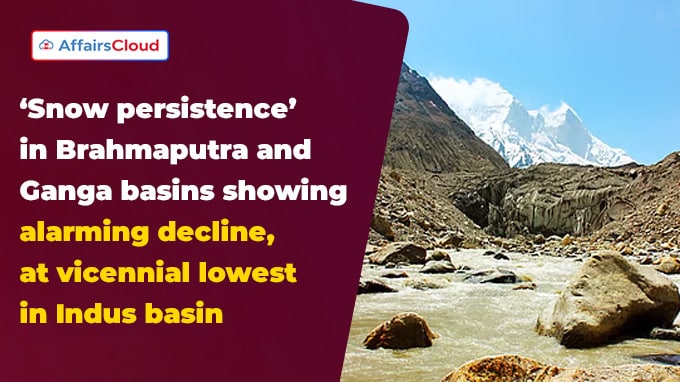 On 21 April 2025, the Kathmandu (Nepal) based International Centre for Integrated Mountain Development (ICIMOD) released the HKH Snow Update Report 2025, highlighting significant declines in snow persistence across the Ganga, Indus, and Brahmaputra river basins of the Indian Subcontinent.
On 21 April 2025, the Kathmandu (Nepal) based International Centre for Integrated Mountain Development (ICIMOD) released the HKH Snow Update Report 2025, highlighting significant declines in snow persistence across the Ganga, Indus, and Brahmaputra river basins of the Indian Subcontinent.
- ICIMOD analysed a 23-year time series (2003–2025) of basin-scale snow persistence during the November–March snow seasons.
- The Hindu Kush Himalaya (HKH) region, which feeds the Ganga, Indus, and Brahmaputra basins, recorded its third straight below-normal snow year in 2025, with snow persistence 23.6% below normal, the lowest in 23 years.
Note: Snow Persistence is the duration snow remains on the ground after snowfall. It’s vital for water supply in regions like the HKH, supporting rivers and ecosystems.
Key Findings
i.Ganga Basin: Snow persistence peaked at +30.2% in 2015, then fell to a 23-year low of –24.1% in 2025, threatening early-summer river flows.
ii.Indus Basin: After a high of +19.5% in 2020, snow persistence dropped to –24.5% in 2024 and further to –27.9% in 2025, its lowest in two decades.
iii.Brahmaputra Basin: From a peak of +27.7% in 2019, levels declined steadily to –27.9% in 2025, risking hydropower and agricultural productivity.
iv.Tibetan Plateau: The source region for many North Indian rivers saw snow persistence plunge from +92.4% in 2022 to –29.1% in 2025, underscoring its climate sensitivity.
v.Other Basins: The Mekong (–51.9%) and Salween (–48.3%) experienced the most severe declines, followed by the Yangtze (–26.3%).
Impacts on Water Security and Ecosystems:
i.Seasonal snowmelt contributes approximately 23% of the annual river flows in the HKH basins, and its decline is resulting in reduced river runoff.
ii.Early summer water shortages could disrupt crop cycles, particularly in the Indus and Ganga basins, which support intensive farming.
iii.The HKH’s snowlines have risen by 150 meters (m) since 2024 due to sublimation and warmer winters, exacerbating water stress.
Actions to Tackle Water Scarcity Risks:
ICIMOD recommended that governments and water management agencies take immediate steps by implementing water-saving strategies, enhancing drought preparedness, and relying on scientific data for efficient water resource management to address the rising risk of droughts.
About International Centre for Integrated Mountain Development:
Director General (DG) – Pema Gyamtsho (Bhutan)
Headquarters – Kathmandu, Nepal
Founded – 1983




